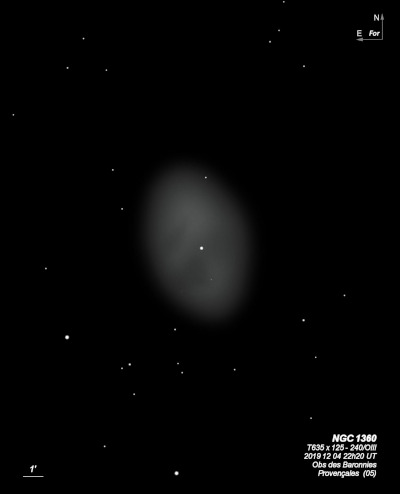
80mm finder (1/1/08): faintly visible at 25x as a dim oval glow surrounding a faint star. Adding an OIII filter significantly increased the contrast and the outline appeared better defined.
Lewis Swift probably discovered NGC 1360 in 1859 with his 4.5-inch comet-seeker (discovery not published until 1885, though). Wilhelm Tempel independently discovered it on 9 Oct 1861, along with NGC 1398, using his personal 4-inch Steinheil refractor from Marseille, but he didn't publish his observation either. Friedrich August Winnecke then found it again in Jan 1868 with his 3.8-inch comet-seeker, estimating a diameter of 10', as well as Eugen Block on 18 Oct 1879 (AN 2293). Dreyer credited Winnecke with the discovery in the GC Supplement (5315). Afterwards, Tempel published his find in 1882, claiming an earlier discovery.
Finally, in the Mar 1885 issue of "The Sidereal Messenger: A Monthly Review of Astronomy" Swift reported that "in 1859 while searching in Eridanus for comets I ran upon the most conspicuous nebulous star visible from this latitude - a 7th magnitude star nearly in the center of a bright nebulosity. As both were so bright, I, of course, supposed they were well known. Not until five years since was I aware that this wonderful object was not in the G.C." Dreyer credited Swift (his earliest discovery) and Winnecke in the NGC. So, NGC 1360 was independently "discovered" by four observers, the most (along with NGC 6364 and 7422) for any NGC number, according to Wolfgang Steinicke. Robert Innes found it again on 8 Dec 1909 and reported it as "easily seen in the 2-inch finder as in the 9-inch" (Union Observatory, Johannesburg). He noted it was oval nebula with the longer axis SW-NE, but apparently wasn't realize of the previous discoveries.
This is one the brightest objects missed by the Herschels as well as by John Dunlop. In 1914, Hardcastle classified NGC 1360 as a spindle-shaped nebula. The following year, Knox-Shaw at the Helwan Observatory reported it wasn't a spindle but was "probably like the Owl", based on a photograph taken with the Reynolds reflector. Minkowski first classified it as definitely a planetary in 1946. A star was incorrectly plotted at the position on the Uranometria 2000 Atlas (first edition) because the CoD and CPD catalogue (used as a source for the U2000) included the central star.
300/350mm - 13.1" (10/10/86): very large, oval 4:3, very bright mag 10-11 central star. Impressive at 88x using an OIII filter.
13.1" (10/20/84): large, pale oval ~N-S, bright central star. Appears moderately bright using a filter.
400/500mm - 17.5" (11/17/01): At 100x with OIII filter, this huge planetary appears a very large oval 3:2 or 4:3 SSW-NNE, ~6'x4.5' with a striking central star. Appears clearly brighter on the north side of the central star in a section defined by a triangular wedge with apex at the central star. The nebulosity dims a bit on the west side as well as the south.
17.5" (10/8/88): very bright, elongated 3:2 SSW-NNE, 6'x4' diameter, very bright mag 11 central star, almost even surface brightness. Very impressive planetary with or without OIII filter.
Notes by Steve Gottlieb